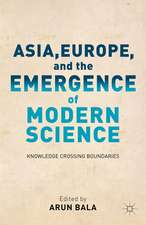State, Religion, and Revolution in Iran, 1796 to the Present: Middle East Today
Autor B. Moazamien Limba Engleză Paperback – 7 noi 2013
| Toate formatele și edițiile | Preț | Express |
|---|---|---|
| Paperback (1) | 636.80 lei 6-8 săpt. | |
| Palgrave Macmillan US – 7 noi 2013 | 636.80 lei 6-8 săpt. | |
| Hardback (1) | 642.18 lei 6-8 săpt. | |
| Palgrave Macmillan US – 2 oct 2013 | 642.18 lei 6-8 săpt. |
Din seria Middle East Today
-
 Preț: 306.57 lei
Preț: 306.57 lei - 8%
 Preț: 459.53 lei
Preț: 459.53 lei - 18%
 Preț: 687.44 lei
Preț: 687.44 lei - 18%
 Preț: 896.39 lei
Preț: 896.39 lei - 15%
 Preț: 696.68 lei
Preț: 696.68 lei - 18%
 Preț: 1004.00 lei
Preț: 1004.00 lei - 18%
 Preț: 898.26 lei
Preț: 898.26 lei - 15%
 Preț: 471.69 lei
Preț: 471.69 lei -
 Preț: 389.70 lei
Preț: 389.70 lei -
 Preț: 390.08 lei
Preț: 390.08 lei - 15%
 Preț: 497.77 lei
Preț: 497.77 lei -
 Preț: 391.61 lei
Preț: 391.61 lei - 15%
 Preț: 659.70 lei
Preț: 659.70 lei - 18%
 Preț: 731.41 lei
Preț: 731.41 lei -
 Preț: 387.75 lei
Preț: 387.75 lei - 18%
 Preț: 728.60 lei
Preț: 728.60 lei - 18%
 Preț: 726.37 lei
Preț: 726.37 lei - 15%
 Preț: 643.34 lei
Preț: 643.34 lei - 15%
 Preț: 696.50 lei
Preț: 696.50 lei -
 Preț: 389.70 lei
Preț: 389.70 lei - 15%
 Preț: 586.55 lei
Preț: 586.55 lei -
 Preț: 384.86 lei
Preț: 384.86 lei -
 Preț: 389.70 lei
Preț: 389.70 lei -
 Preț: 383.93 lei
Preț: 383.93 lei -
 Preț: 388.72 lei
Preț: 388.72 lei -
 Preț: 390.63 lei
Preț: 390.63 lei - 15%
 Preț: 642.83 lei
Preț: 642.83 lei -
 Preț: 387.75 lei
Preț: 387.75 lei -
 Preț: 388.72 lei
Preț: 388.72 lei -
 Preț: 418.67 lei
Preț: 418.67 lei - 15%
 Preț: 642.51 lei
Preț: 642.51 lei - 15%
 Preț: 643.34 lei
Preț: 643.34 lei - 15%
 Preț: 584.92 lei
Preț: 584.92 lei -
 Preț: 425.80 lei
Preț: 425.80 lei -
 Preț: 386.81 lei
Preț: 386.81 lei
Preț: 636.80 lei
Preț vechi: 749.19 lei
-15% Nou
Puncte Express: 955
Preț estimativ în valută:
121.87€ • 132.33$ • 102.37£
121.87€ • 132.33$ • 102.37£
Carte tipărită la comandă
Livrare economică 23 aprilie-07 mai
Preluare comenzi: 021 569.72.76
Specificații
ISBN-13: 9781137325884
ISBN-10: 1137325887
Pagini: 224
Ilustrații: XIII, 208 p.
Dimensiuni: 152 x 229 x 15 mm
Greutate: 0.32 kg
Ediția:2013
Editura: Palgrave Macmillan US
Colecția Palgrave Macmillan
Seria Middle East Today
Locul publicării:New York, United States
ISBN-10: 1137325887
Pagini: 224
Ilustrații: XIII, 208 p.
Dimensiuni: 152 x 229 x 15 mm
Greutate: 0.32 kg
Ediția:2013
Editura: Palgrave Macmillan US
Colecția Palgrave Macmillan
Seria Middle East Today
Locul publicării:New York, United States
Cuprins
1. Introduction: State, Religion, and Revolution in Iran, 1796 to the Present
SECTION I: FROM FRAGMENTED POLITICAL AUTHORITY TO CENTRAL BUREAUCRATIC POWER, 1796–1963
2. The Political Authority of the Qajar State, 1796–1925
3. Forming a Utilitarian Buffer State: The Pahlavis, 1921–1963
SECTION II: THE INSTITUTIONALIZATION OF THE SHI'I ULAMA, 1796–1963
4. Religious Revivalism and the Formative Phase of Orthodoxy, 1796–1892
5. The Constitutional Moment: The Ulama and the Political Sphere, 1892–1921
6. The Nationalization of Religious Morality and the Organizational Expansion of the Ulama, 1921–1963
SECTION III: THE MAKING OF THE ISLAMIC REVOLUTION AND ITS AFTERMATH, 1963 TO THE PRESENT
7. The Islamization of the Social Movements and the Revolution, 1963-1979
8. The Invention of a Modern Theocracy: An Unfinished Revolution
9. Conclusion: Making Sense of the State, Religion, and Revolution
SECTION I: FROM FRAGMENTED POLITICAL AUTHORITY TO CENTRAL BUREAUCRATIC POWER, 1796–1963
2. The Political Authority of the Qajar State, 1796–1925
3. Forming a Utilitarian Buffer State: The Pahlavis, 1921–1963
SECTION II: THE INSTITUTIONALIZATION OF THE SHI'I ULAMA, 1796–1963
4. Religious Revivalism and the Formative Phase of Orthodoxy, 1796–1892
5. The Constitutional Moment: The Ulama and the Political Sphere, 1892–1921
6. The Nationalization of Religious Morality and the Organizational Expansion of the Ulama, 1921–1963
SECTION III: THE MAKING OF THE ISLAMIC REVOLUTION AND ITS AFTERMATH, 1963 TO THE PRESENT
7. The Islamization of the Social Movements and the Revolution, 1963-1979
8. The Invention of a Modern Theocracy: An Unfinished Revolution
9. Conclusion: Making Sense of the State, Religion, and Revolution
Recenzii
Notă biografică
Behrooz Moazami is Associate Professor of History and Director of Middle East Peace Studies at Loyola University New Orleans, USA. An Iranian political activist, he holds two doctorates, one in political science and one in sociology and historical studies. Before joining academia, he worked as a journalist, essayist, and co-editor of various dissident publications
Textul de pe ultima copertă
Two basic assumptions have shaped understanding of recent Iranian history. One is that Shi'ism is an integral part of Iran's religious and cultural landscape. The other is that the ulama (religious scholars) have always played a crucial role. This book challenges these assumptions and constructs a new synthesis of the history of state and religion in Iran from 1796 to the present while challenging existing theories of large-scale political transformation. Arguing that the 1979 revolution has not ended, Behrooz Moazami relates political and religious transformations in Iran to the larger instability of the Middle East region and concludes that turmoil will continue until a new regional configuration evolves.
Caracteristici
A lucid and wellfocused examination of the complex and changing relationship between the clergy and the state over two centuries in Iran Challenges the dominant cultural interpretation of the Islamic Revolution, correcting longheld assumptions about the influence of Shi'ism on Iranian culture and the role of religious elites in Iran's history Timely and relevant an important resource for understanding Iranian politics Broad historical scope (covering the time from the inception of the Qajar period (1796) through the dramatic postelection crisis of 2009)
















